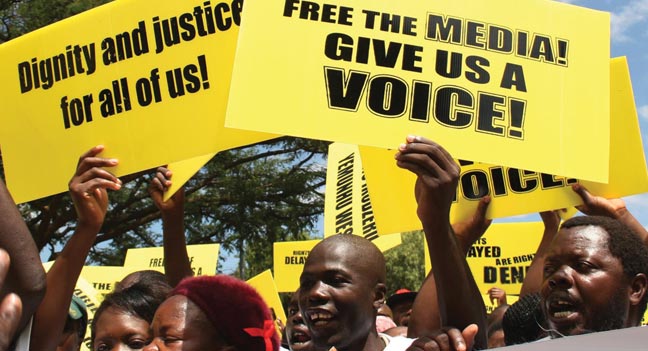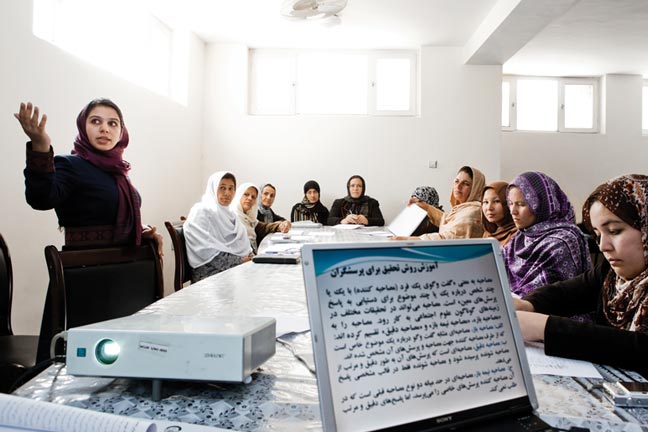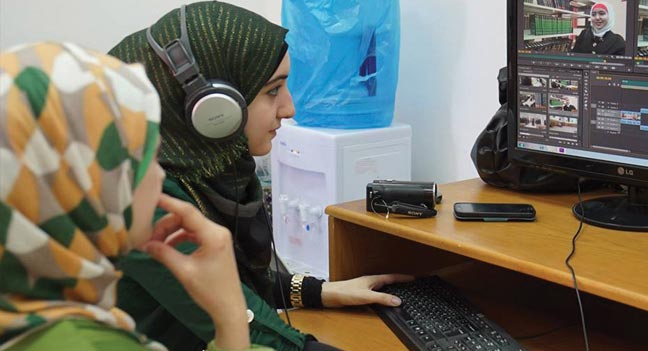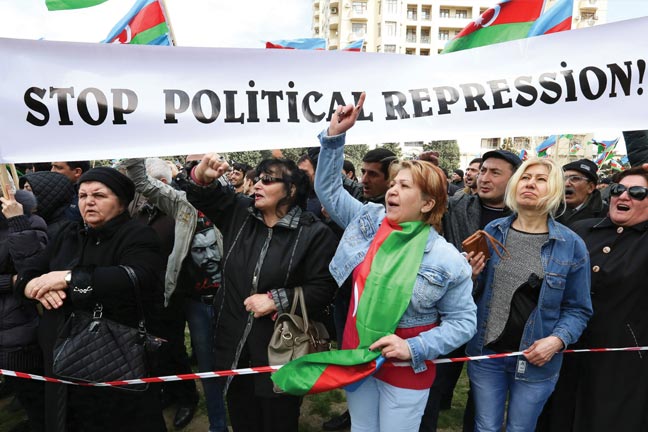AFRICA
THe battle for THE dominant message
With an increase in targeted violence and political pressure in East and Southern Africa in 2015, we focused our efforts on strengthening the safety of media workers and on the production of diverse and balanced content, bridging information gaps and mitigating political or gender-based bias.
Somalia has the dubious honour of hosting one of Africa’s longest running conflicts, with the media under heavy fire in particular. As the country moves ahead, our work seeks to address some of the vast challenges facing the country’s media to enable it to become a driver of peace, reconciliation, accountability and citizen participation. In late 2015 IMS and our Swedish partner organisation, Fojo, along with local media organisations, spearheaded the development of a five-year media support strategy for the Somali media sector – a first for the country. The strategy emphasises the importance of boosting safety for journalists and seeks to adress gender related challenges. The latter is much to the credit of IMS’ partners stressing the particular risks female journalists face. Together with a network of Somali organisations, Fojo and IMS are working to establish a national protection mechanism for journalists. Here IMS draws on our expertise and best practices from similar setups in Asia.
In Zimbabwe, sexual harassment in newsrooms is among the most common forms of gender discrimination. More than 50 per cent of women working in the media have experienced sexual harassment, found a report from IMS partners. A key focus of IMS’ work in 2015, was raising awareness of the effect of gender discrimination in media products, as well as access, participation and portrayal of men and women in the media. All this with a view for partners to develop gender policies, action plans and integrating gender considerations in programmes.
In IMS we recognise that media play an important role in the prevention of extremism. In Niger it is imperative that journalists are able to counter the influence of jihadists active in neighbouring countries. Our three-year programme in Niger is funded by Danida and implemented in collaboration with consortium partners Panos Institute West Africa and ARTICLE 19. The programme took off in late 2014, and centers on boosting responsible journalism, including through enhanced regulation. The project manager from the media regulatory body, the High Council for Communication (CSC) recognises the value of the IMS partnership:
“In my view, the partnership has significantly improved the interventions of the CSC. It has built capacity in matters of media regulation in Niger. This particularly through the establishment of our regional offices, and through increased productivity and improved visibility of the CSC.”
Our rapid response approach entails assessing and reacting immediately to demands of independent media in countries where they are targets in evolving emergencies. When a political crisis erupted in Burundi in May 2015, following President Pierre Nkurunziza’s refusal to leave office, nearly all independent media outlets were closed or destroyed in only a few weeks – prompting more than 100 journalists to flee the country.
Seeking to counter the state-controlled narrative and provide access to independent information, our rapid response intervention resulted in support to the Burundian online radio Inzamba, produced by exiled media workers in Rwanda. In addition to online streaming, Inzamba reaches hundreds of people daily through WhatsApp and efforts are ongoing to make the broadcasts available via satellite. However, listening to Inzamba’s news is not without risk. A listener in the northern Kanyanza province of Burundi told Inzamba’s director:
“Yes, I listen to Inzamba, but because of fear of being arrested by the police, you listen to Inzamba when you are in your bedroom and you use earphones.”
The importance of Inzamba cannot be underestimated – not only does it provide important news and information to Burundians around the world, it also provides Burundian journalists in exile an outlet through which they can continue to work and serve their communities.
Wherever you look across the African continent, whether in Somalia, Zimbabwe, Niger, or Burundi, there is a lot to be proud of – and surely, a a lot more to do.
 Finn Rasmussen
Finn RasmussenIMS Senior Programme Manager for Somalia
STORIES OF CHANGE
Legal landmark in Zimbabwe

Demonstrators in Harare commemorate the international human rights day on 10 December. Photo: AP/Polfoto
Although press freedom in Zimbabwe retains the classification of ‘Not Free’ in global rankings, the country took a step in the right direction when a February 2016 ruling by Zimbabwe’s Constitutional Court ruled criminal defamation invalid and unconstitutional.
The legal ruling is an important improvement of Zimbabwe’s media environment and is a landmark achievement by the Media Institute of Southern Africa (MISA) Zimbabwe, which filed the court application following years of dedicated lobbying, supported by IMS and other likeminded organisations.
“Such laws have no place in a democratic society. There are alternatives; aggrieved parties can file complaints with bodies such as the Voluntary Media Council of Zimbabwe and pursue civil actions for defamation in courts of law,” says National Director Nhlanhla Ngwenya from MISA Zimbabwe.
Criminal defamation laws intimidate individuals from exposing wrongdoing by public officials. MISA had been fighting to engage with government as well as opposition leaders on the harmful effects of criminal defamation since 2004 but the lobbying did not yield the desired results and MISA decided to re-calibrate. With strategic input and support from IMS, lawyers together with MISA, decided to directly engage with the country’s judicial system, with lawyers providing legal assistance and seeking release, whenever journalists got arrested on defamation charges. One of the cases that came from that strategic shift ultimately led to this ruling.
The ruling is a big leap towards alignment of the domestic legal framework with international standards on media freedom and freedom of expression. But with a pervasive culture of fear amongst media practitioners, many may still hesitate to bring their cases to court. Mindful of the many remaining statutes that can still be used to criminalise freedom of expression and hamper independent journalistic enterprises, MISA Zimbabwe will continue their work challenging the laws where necessary, says Nhlanhla Nqwenya.
Prior to the ruling by the Constitutional Court, journalists risked arrest and charges for defamation under Section 96 of the Criminal Law (Codification and Reform) Act, with fines or prison of up to two years.
ASIA
A focus on safety AS perils grow
“The Government is doing what it can to enhance media freedom. We will do our part. Are you ready to do yours?”
Those were the words of Sri Lankan Prime Minister Ranil Wickremesinghe spoken to local media at an event on World Press Freedom Day co-hosted by IMS in Colombo in May 2016. Sri Lanka has been at the bottom of global press freedom indices for more than a decade, but in 2015 came to represent one of the most encouraging developments in the area of press freedom in South and Southeast Asia – a year which also saw deeply worrying trends. In countries such as Myanmar, Sri Lanka, Nepal and Bhutan, we contributed to progress on media law reforms while the increased targeting of journalists by terrorist groups or authorities in Afghanistan, Pakistan and Bangladesh demanded a strong focus on improving the safety of journalists.
In Sri Lanka, a new government elected in August 2015, embarked on a fresh discourse of democratic reform, showing a will to expand the space for freedom of expression. Our continuous presence in the country since 2003, enabled us to react promptly to this window of opportunity when the new government showed signs of aspiring for change. In May 2016, together with the Secretariat for Media Reforms, a coalition of Sri Lankan organisations, IMS presented the country’s new reform-oriented government with a roadmap for the development of an independent and pluralistic media sector based on UNESCO’s Media Development Indicators.
The landslide victory of Aung San Suu Kyi’s National League for Democracy party in Myanmar provided renewed hope for further change after a marked slowdown in media reform efforts. With support from the Danish, Swedish and Norwegian governments, IMS, together with the interim press council launched the first code of conduct for Myanmar journalists. A 2015 survey of 134 journalists shows that the code of conduct is well-known and used across the country.
Considering that Myanmar’s population until 2011 lived in a virtual information blackout for more than 50 years, the establishment of a coalition of civil society organisations and media working to promote Right to Information (RtI) legislation is a milestone in the country’s media reform process. RtI is important because it ensures the public’s right to request information from public institutions, which in turn minimises the chances of corruption and abuse of power. A draft RtI law has been shared with the new NLD-led government and advocacy efforts together with IMS’ partner, the Center for Law and Democracy, will continue in pursuit of government action.
Similar hopes for pushing forward media development efforts are tied to the thorough assessment of Myanmar’s media environment published by IMS in June 2016, building on UNESCO’s Media Development Indicators. The analysis is emerging as an important advocacy tool by both Myanmar and international stakeholders in their pursuit of change.
In Nepal, sustained lobbying by IMS and partners in the Nepal International Media Partnership to improve the safety of journalists is having substantial effect. The organisation with the necessary legal powers to undertake investigations, the National Human Rights Commission, is establishing a national mechanism that addresses the safety of journalists and human rights defenders and the impunity for those who attack them.
While the mechanism is not yet functional, its implementation delayed by the devastating earthquake in April 2015, we have assisted the Commission in preparing the necessary policy frameworks to allow it to become operational.
In Afghanistan, the Taliban’s renewed hostility towards the media in 2015 posed a severe challenge to which the country’s nationwide journalist safety mechanism was quick to react. The IMS-supported Afghan Journalists’ Safety Committee (AJSC) evacuated more than 70 journalists, many of them women, during the Taliban’s takeover of the northern city of Kunduz in autumn 2015.
A central part of AJSC’s effectiveness stems from its community-based approach to setting up safety and emergency response mechanisms. Safety coordinators in eight provinces use risk analyses of local power structures in their communities to tailor safety and emergency strategies for journalists. Where Islamic State or the Taliban may be the main forces to reckon with in one province, it may be warlords or religious leaders in another. Some provinces have cooperative police forces, in others, journalists must find other avenues of support. In Nangarhar, AJSC has signed the first agreement with the local government to provide support to media in emergencies.
Following a Taliban attack on Tolo TV in January 2016 in Kabul which killed seven media workers, IMS and AJSC provided input to more than 10 media houses on in-house safety strategies for media staff and their families in work-related emergencies. Having safety packages in place is also a means of encouraging journalists to remain in Afghanistan.
In light of the dire situation for journalists, the government of Pakistan has shown encouraging signs of considering a legislative framework that protects the rights of media workers and enables speedy, conclusive trials on crimes against journalists. In spring 2016, after years of advocating the government for change, the Pakistan Federal Union of Journalists, and a number of local media stakeholders provided the Pakistani government with input on a media workers protection law.
In a parallel track under the auspices of a Danish government-supported two year media development programme, some of Pakistan’s leading journalists, media managers, human rights activists and civil society members have formed an expert group to draft a national agenda that outlines for the first time ever a priority action plan on effecting broad-ranging media reforms.
In another unique show of solidarity, six press clubs across Pakistan representing over half of Pakistan’s community of 18,000 journalists have worked together to establish journalist safety resource hubs at their premises. Pakistan has thereby joined a small club of countries where civil society, with IMS technical support and advice, has developed local safety mechanisms that assist journalists in distress, which document attacks against journalists and advocate authorities at provincial and national levels to address the safety cases.
The work that goes on across organisations and countries globally to address the safety of journalists also continues under the auspices of the UNESCO-led UN Plan of Action for the Safety of Journalists and the Issue of Impunity. This global process enables those of us working on media safety to improve cooperation and sharing of best practices so crucial to turning the tide of attacks against media.
 Lars Bestle
Lars BestleHead of IMS Asia Department
STORIES OF CHANGE
Afghanistan’s Reporting heroes

Female journalists trained in conflict sensitive journalism by Afghan Journalists’ Safety Committee. Photo: Lars Schmidt
Working as a journalist in Afghanistan, one of the world’s most dangerous environments is one thing. Working there as a woman, is an added challenge.
Luckily, there are many Afghan women like the 26-year-old Nazira Babouri, whose will to change circumstances not only for women in their country, but also to provide a voice for other minority voices in Afghan society, drives their desire to work as journalists.
“It’s about empowerment of women and I became a journalist because I want to be remembered,” she explains.
“Women in Afghan society have many problems that men simply do not wish to report on, like sexual harassment. And women subjected to sexual harassment do not want to talk to male reporters about this.”
As a safety coordinator in the IMS-founded Afghan Journalists’ Safety Committee, a network that implements a country-wide safety mechanism for Afghan journalists in distress, Nazira Babouri and AJSC have organised meetings with editors of media houses to encourage them to address the skewed gender balance amongst their staff and their sources.
While their response often pertains to their perception that female journalists lack the necessary education to perform the positions in journalism filled by men, AJSC has provided both skills and safety training to female journalists to strengthen their position in the workplace.
“In Kabul University, there are now more female journalists than male,” explains Nazira Babouri. “But they often disappear once they have graduated because their families do not support their wish to work in journalism, which is one of the main challenges faced by women. However, as a working journalist I can be a role model for what other women can do – and I for one want to help change the minds of people through my work.”
Also social media has empowered Afghan women. Things said and written by women that would have been unthinkable and certainly punishable less than ten years ago, now regularly appear on Afghan Facebook timelines.
The Afghan Journalists’ Safety Committee, is a countrywide, locally led 24/7 safety mechanism, which provides assistance to journalists in distress, monitors incidents and provides male and female journalists with tailored safety advice and practical safety measures.
MIDDLE EAST & NORTH AFRICA
Pockets of Media excellence amid repression
The silencing of critical voices through the means of despotism and armed conflict left the Middle East and North Africa behind as one of the most dangerous regions in the world to practice journalism. In an environment of killings, threats, imprisonment and stigmatisation, our partners continued to produce high quality news based on ethical and professional standards, illustrating the enormous potential of the region’s journalists, civil society representatives, and human rights defenders — future leaders, who despite their surroundings, work tirelessly to offset the seemingly never-ending spiral of calamities.
The region’s relative bright spot Tunisia battled spill-over insecurity in its border areas, internal threats from jihadist groups, and a pushback against human rights and democratic reform, but media and civil society groups still forged ahead. Our partner, the Tunisian National Journalists’ Syndicate succeeded in securing provisions that protect journalists and allow them to shield their sources in a new counterterrorism bill. The Syndicate’s ability to intervene came as a direct result of our institutional support, which allowed them to free up resources to focus on substantive matters.
In the region’s gloomy setting for independence and innovation, Tunisia’s collective blog platform, Nawaat continued to provide a glimmer of hope, providing investigative reports and opening the space for a variety of opinions and debates. Our work with Nawaat enabled them to strengthen the quality and reach of its video productions by setting up and coaching dedicated editorial and technical teams. A testament to its broad reach, Nawaat’s YouTube channel was watched more than two million times over the course of 2015.
At the other end of the spectrum from Tunisia’s relatively constructive progress, were Yemen, Syria, Iraq, and Egypt. In Egypt, the tightening of state security measures and the threat from violent extremists provided for a severely challenging environment for the country’s independent media and civil society. In the case of Yemen, civil war and a vast humanitarian crisis led to an almost complete shutdown of the few independent media available with exile initiatives established elsewhere in the region. One of them, Almashahid.net, was launched with the assistance of IMS. It seeks to counterbalance the propagandistic news coming out of media run by Houthi rebels and President Hadi, says the editorial team behind the site:
“No one has any interest in exposing the horrors of this war and meanwhile the Yemeni population continues to suffer and is misled by propaganda. We need to change this.”
Propaganda also filled the information spheres of Syria where the despotism of President Assad and the violence of extremist groups rose to unparalleled levels of brutality. The massive displacement of people had a major impact on the media, shifting journalists and their audiences into surrounding countries. With its unrivalled presence of correspondents in Syria and surrounding areas, our partners continued their coverage of the conflict and the consequences for the millions displaced as a result.
Our support to the award-winning Radio Rozana, allowed it to further its position as one of the most reliable media outlets covering Syria. It developed new relationships with other media and human rights partners such as the Violations Documentation Centre, the investigative journalism network ARIJ, and the website Syria Untold as well as international media houses which all benefitted from the radio’s unique network of 120 correspondents inside Syria. We also continued our work with the Syrian Network for Print Media, a group of newspapers seeking to reach similarly inaccessible audiences. The group succeeded in distributing around 30,000 newspapers weekly through more than 600 distribution points in Turkey and in northwestern Syria, successfully providing readers with a diversity of reliable news and information. In 2015, an independent monitoring of the papers’ content found significant improvements across the board with higher ethical standards, innovative angles and improved visual appearance. Sourietna, one of the member papers of the Network was awarded the Judge’s Special Recognition at the European Newspaper Awards.
In Iraq, the situation evolved from bad to worse, with the already highly fragile media environment under sustained attack from both violent extremists and formal instruments of repression. A counterbalance in the public narrative for those who are most at risk, we supported the women’s magazine, Zhin, an unlikely success story in Iraqi Kurdistan where entrenched gender inequality and violence against women are still widespread. The magazine produces stories ranging from the female fighters who battle against Islamic State to the latest trends in fashion.
“People are tired of only hearing about the miserable parts of women’s lives. They want to read about those who succeed,” says Ala Lattif, the editor of Zhin.
As threats against journalists continued to grow, so did our work to ensure their safety with legal protection provided through the Iraqi Network of Lawyers for Freedom of Expression, a voluntary network of lawyers defending journalists. The lawyers won 16 cases and settled another seven out of court in 2015.
Jordan also battled with its own internal tension and challenges, but remained comparatively stable. Our work there continued in the form of journalistic training of a network of female journalists from the journalism faculty of the local university in the conservative southern province of Ma’an. The network secured regular production of TV reports from Ma’an for the national independent broadcaster Roya TV, giving a public voice to local women.
“We tell women about their rights and duties,” says Hanifa who also covered campaigns of female candidates for parliament to inspire local women. “We plant the seeds of change through our programmes. We plant respect for women,” she says.
Planting the seeds of change is one of the hallmarks of our documentary film work in the region as well as in Iran, where we in 2015 began working with the public Tehran University. Following a film education study trip abroad, the university launched a course entitled “The Arne Bro Methodology” in a clear reference to the vice-director Arne Bro at the National Film School of Denmark. Supported productions in 2015 included the documentary “Speed Sisters” by the Palestinian SocDoc Studios, a remarkable film that follows four female race drivers in the West Bank. The film premiered at the Hot Docs film festival in Toronto in early 2015 and has a won a variety of international prizes.
Whether through documentary film or journalism, our media partners and the civil society and human rights groups we work with across the Middle East and North Africa, have persisted throughout 2015 and into 2016 to bring about real change, informing and expanding the space for expression and debate in some of the most dangerous environments in the world. Whether they are established legacy media, new, emerging media actors, or long-standing civil society groups they represent true pockets of media excellence in the repressive and conflict-affected contexts. Pockets of excellence that seek to transform societies, that seek peaceful development and progress, providing encouragement as they push back against repression.


Thora Gehl & Michael Irving Jensen
Heads of IMS MENA Department
STORIES OF CHANGE
The last voice of Aleppo

A man stands in a bombed building in the Syrian town Azaz outside Aleppo. Photo: Christiaan Triebert used under CC BY-NC 2.0
“We don’t have homes,” says Kareem, as he explains the setup of the radio station. “Everyone sleeps in the office.” He and his colleagues are working around the clock to bring Aleppo’s citizens coverage of the incessant attacks on the city.
“Our families are far away and we can’t reach them because of attacks and the bad roads.”
Kareem’s radio station, Aleppo Media Centre is arguably one of the last independent voices left in Aleppo, a city that has nearly ceased to exist after years of sitting at the centre of much of Syria’s civil war. Kareem and his colleagues are determined to report on life in the divided city. AMC has a dedicated team of correspondents distributed around the province, he says. They cover areas otherwise impossible to reach for both national and international journalists.
With IMS’ assistance the staff of the radio set up a studio and a transmitter, extending their reach and enabling them to target a larger audience. Every morning, the radio broadcasts two hours on FM and satellite. Its content is also re-broadcast on the satellite radio network, Ma3akom together with other Syrian radios, including Radio Rozana.
Their workday is determined by what goes on, he says. But where that might mean a press conference or a political scandal anywhere else, in Aleppo, the daily attacks are of principal concern.
“It is according to when and where the bombings take place,“ he says. “That’s usually the first agenda point of the day.” Their coverage is popular, he says, sharing positive feedback from listeners broadcast live with the help of a smartphone app.
The bombings and endless attacks make it nearly impossible to operate a business, let alone a media outlet in the city. But that does not deter Kareem and his team.
STORIES OF CHANGE
Media for accountability

Journalists participating in the Women’s Network of Journalists that produce Minna wa Feena, a TV programme covering local issues in Jordan’s remote regions. Photo: Jon Rytter
In Jordan, IMS works with media partners who strive for social justice and seek to bring about change on a community level — change that is seen, heard, and felt by local citizens, change that matters.
Illustrating the media’s ability to hold those in power to account, Minna wa Feena, a TV programme covering local issues in Jordan’s remote regions, reported in 2015 on a medical centre in Ma’an that was no longer in operation. Following coverage of the reluctance by the official in charge of the centre to answer critical questions from the journalist behind the report, the Ministry of Health immediately secured all the equipment needed to get the medical center up and running again and start serving its citizens.
Another report by Minna wa Feena covered a failed water infrastructure project that stood unfinished two years after its planned completion date. After the report was broadcast, officials from the municipality of Zarqa were publically shamed for their sluggishness and inaction. They responded quickly by putting extra manpower aside to finish the project.
Finally, coverage of a group of Syrian refugees by 7iber, one of Jordan’s most popular online platforms, illustrated the media’s ability to facilitate public debate. With the hundreds of thousands of refugees in Jordan, 7iber decided to focus parts of its coverage on the entrepreneurial skills of the Syrian refugees who rebuild their lives by setting up small innovative businesses. Contributing to a more nuanced coverage of the refugee crisis in the region, the story’s popularity prompted 7iber to organize a public debate on the media coverage of the crisis in February 2016 to further a more responsible public understanding of the crisis.
Latin America
Zooming in on Peace efforts
Breaking news and opinion reporting rather than in-depth analysis have continued to characterise reporting on Colombia’s peace talks during the past year, the focus areas of IMS in the region. The country’s media needs an injection of investigative and balanced coverage, in order to give increased visibility to the central players of the peace process living in rural areas.
In order to address these challenges in the context of the peace negotiations between the government and the FARC and the current process of transition in Colombia, IMS and its Colombian partners developed a project to build the capacity of the media and Colombian journalists to play an active, fair and balanced role during this period, shifting the reporting focus to one of reconciliation and construction of scenarios conducive to transition and peaceful coexistence.
The first phase of the project focused on the role of the media in promoting the reduction of conflict and revealing the implementation of the peace process and the path towards transition in five high risk departments in Colombia: Norte de Santander, Arauca, Antioquia, Valle del Cauca and Nariño.
For IMS, the issue of linking and understand quality journalistic content and safety remains at the heart of our approach and focus in Colombia. With over a decade leading global safety efforts and investigative reporting initiatives, IMS continued to support these inter-linked issues by supporting both local media outlets and support groups across the country in 2015.
IMS' work shed light on the reach of the peace process in rural zones and used innovative approaches to address the challenges that the transition imposes on local communities. The project also initiated and maintained dialogue between the government security forces and the media and journalists in order to reach an understanding about the role of the media in this specific context.
The project achieved a good balance of regions, types of media, gender and experience of the journalists, and a prior commitment by the media to facilitate the process with each one of the journalists during the duration of the project.
The collaborative work also increased the number of trainings and high-quality publications. Sixteen investigative reports were completed, which have been published in regional and national media. One of the investigations even won the Alfonso Bonilla Aragon journalism award.
 Robert Shaw
Robert ShawIMS Latin America Adviser
EASTERN EUROPE, CAUCASUS & CENTRAL ASIA
Pushing back Against control
From a geopolitical standpoint, the Eastern Europe, Caucasus and Central Asia (ECCA) region remains as important as ever. As events in Ukraine have demonstrated, Russia continues to shape the trajectory of political and human rights developments across the former Soviet republics, bringing additional challenges for independent media and civil society in the region.
As the year unfolded, conditions for media in the region deteriorated sharply with journalists and activists struggling with mounting restrictions on the free flow of news and information — in addition to grave threats to their own lives.
In Azerbaijan, where our partners and we worked to promote press freedom until 2014, censorship and state control of the media has become deeply entrenched. Those who have dared to challenge government restrictions have done so at great personal risk – potentially facing imprisonment, assault and intimidation.
Over the years, our Azerbaijani journalist and human rights defender colleagues have been thrown in jail on fabricated charges, media outlets have been shut down and civil society groups have been forced into exile. Bringing about any form of change in Azerbaijan seemed near impossible. IMS was one of the few that chose to stay. At a time when Azerbaijan had one of the most restrictive media and civil society environments in the region, “Sport for Rights”, an international advocacy campaign for free expression, set sail.
The campaigning alongside a host of other initiatives by international and national actors, along with evidence-based advocacy, contributed to the release of a number of political prisoners, including prominent journalists and human rights defenders.
In Ukraine, we launched back in 2008 an ambitious media law reform initiative with support from Danida. The immediate reaction from some stakeholders was that we were aiming too high. Today, the legal framework for the media in Ukraine is among the most progressive in Eastern Europe and Eurasia. We are incredibly proud to see that years of perseverance and hard work by our partners has resulted in the passage of several groundbreaking pieces of media legislation, including laws on transparency of media ownership, access to information, and the privatisation of state owned print media. Work by IMS and our partners has been instrumental in terms of drafting another landmark piece of legislation – this time on the protection of whistleblowers. The new draft law is important because it raises awareness among public servants that whistleblowing does not constitute a form of betrayal and that they are provided with adequate legal protection in case of whistleblowing.
The reform process in Ukraine and the results of advocacy efforts in Azerbaijan over half a decade serve as a collective reminder that development is often a gradual process. However, IMS’ long-term engagement and strategic patience in countries like these proves that we can make a meaningful contribution to fostering change during long-term transitions. Change that enables the media to provide people with independent news and information — news and information that acts a counterbalance in the information spheres that are so heavily dominated by propaganda, rumour, and fabricated stories designed to win the battles of information war that are waged subtly side by side with armed conflict.
In Central Asia, IMS has brought innovation to areas where the mainstream media fails to inform public discourse via robust, issue-led journalism. In Kyrgyzstan, we are excited to follow the rapid growth of Kloop, a long-time partner of ours. What began as a training institution for young people with a website has developed into a fully fledged multi-platform media organisation that produces content not only for web, but also radio, video and live online broadcasts. This has multiplied the skills within the organisation and significantly enhanced Kloop’s reputation as the most innovative media organisation in Kyrgyzstan.
 Gulnara Akhundova
Gulnara AkhundovaTeam Leader, Eastern Europe, the Caucasus and Central Asia
STORIES OF CHANGE
Sport for Rights

"Stop political repression," reads a banner during an opposition rally in Baku, Azerbaijan in April 2015. Photo: Aziz Karimov
The Sport for Rights campaign is one of IMS’ most successful advocacy projects. Under the leadership of IMS, Sport for Rights has achieved an incredible amount since it began in April 2015. Through the campaign, a dynamic coalition of 30 international NGOs has worked together to draw attention to the unprecedented human rights crackdown in Azerbaijan, and to increase international pressure on the Azerbaijani regime to uphold its human rights obligations.
The campaign initially focused on the inaugural European Games, which took place in Baku in June 2015, calling on European leaders not to attend the games unless political prisoners were released, and on National Olympic Committees to use the games to take a stand for human rights in Azerbaijan. The campaign also achieved a huge impact in the international press and on social media.
The targeted advocacy and public campaigning approach worked. Very few European leaders attended the games and national Olympic Committees increased their attention to human rights issues in Azerbaijan. Sport for Rights-generated op-eds and news pieces were published internationally and a number of celebrities spoke out, included U2’s Bono on stage in Montreal. Members of the European Parliament made repeated calls for the release of political prisoners and a European Parliament resolution in September 2015 called for the use of individual sanctions against Azerbaijani officials responsible for human rights violations, with similar calls following in the U.S. with the introduction of the Azerbaijan Democracy Act.
In the aftermath of the European Games, the coalition behind Sport for Rights exposed the regime’s crackdown on media and civil society, which flared up once more around the November 2015 parliamentary elections. In an unprecedented step, following calls by the Sport for Rights campaign, the European Parliament, the OSCE/ODIHR, and the OSCE Parliamentary Assembly all cancelled their monitoring missions. The campaign also produced a groundbreaking report on the eve of the election, detailing two years of repression during President Aliyev’s third term in office.
All this intensive work began to yield serious results when a number of political prisoners were released from jail – human rights defenders Leyla and Arif Yunus in November and December 2015, and Intigam Aliyev, Rasul Jafarov, Taleh Khasmammadov, and Anar Mammadli, along with 12 other political prisoners in March 2016. The heavy campaigning by Sport for Rights around these cases as well as a host of other initiatives contributed to the momentum that allowed for their release.
IMS continues to build on the momentum achieved last year, working now with the Sport for Rights coalition in the run-up to Azerbaijan’s next mega-event: the Formula One European Grand Prix, which will be held in Baku in June 2016. The campaign continues to press for the release of the country’s many remaining political prisoners, and for urgently needed broader human rights reforms.



